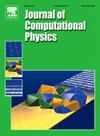SOLEDGE3X中用于托卡马克边缘等离子体湍流模拟的电磁模型
IF 3.8
2区 物理与天体物理
Q2 COMPUTER SCIENCE, INTERDISCIPLINARY APPLICATIONS
引用次数: 0
摘要
在磁约束聚变装置中,即使是很小的磁场波动也会影响边缘等离子体湍流和输运特性。磁感应改变了平行电场,因此,它影响了欧姆定律中的平行电流。此外,磁波动可以引起磁场结构的几何和拓扑变化,导致平衡磁表面上的平行输运。本文提出了在SOLEDGE3X [Bufferand et al., Nuc]中实现的新的减漂流体电磁模型。付,2021]。在区域分解的基础上,利用具有半隐式时间推进的保守二阶有限体积,提出了一种具体的数值格式。在欧姆定律和安培定律中,并联电流j∥与并联电磁势A∥之间的耦合采用了一种新的环形和多向交错网格。当A∥的加入使待反转的涡度算子的大小增大一倍时,数值试验表明,新模型中包含有限质量的电子作为平行扩散系数的上限,从而改善了平行电阻率η∥接近于零时矩阵在高温等离子体下的调节。利用人造解的方法验证了算法的变化。首先对理论线性稳定性结果进行了验证,随着垂直波数的增加,恢复了从阿尔夫萨梅到热电子波的转变。与文献中现有结果的比较表明,在有限的平板几何结构中,单个斑点传播的定性一致。在TCV中首次对等离子体边缘湍流进行了三维模拟,证明了新求解器处理实际托卡马克配置的能力。显式-隐式时间积分方案使人们能够使用相同的求解器比较静电和电磁效应,有或没有电子惯性和磁颤振。这种能力为更好地理解静电和电磁机制对实际托卡马克构型中输运和湍流特性的影响开辟了道路。本文章由计算机程序翻译,如有差异,请以英文原文为准。
An electromagnetic model in SOLEDGE3X for edge plasma turbulence simulations in tokamaks
Even small fluctuations in the magnetic field are known to impact edge plasma turbulence and transport properties in magnetic confinement fusion devices. Magnetic induction modifies the parallel electric field, and as such, it impacts the parallel current in Ohm’s law. In addition, magnetic fluctuations can induce geometrical and topological changes in the magnetic field structure, leading to parallel transport across the equilibrium magnetic surfaces. This paper presents the new drift-reduced fluid electromagnetic model implemented in SOLEDGE3X [Bufferand et al., Nuc. Fus. 2021]. Based on a domain decomposition, a specific numerical scheme is proposed using conservative second-order finite volumes associated with a semi-implicit time advancement. The coupling between the parallel current and the parallel electromagnetic potential in Ohm’s and Ampere’s laws is treated using a new toroidally and poloidally staggered grid. While adding doubles the size of the vorticity operator to be inverted, numerical tests show that the inclusion of the finite mass of the electrons in the new model acts as an upper limit on the parallel diffusion coefficient, thus improving the conditioning of the matrix at high plasma temperatures when the parallel resistivity approaches zero. The changes in the algorithm are verified using the method of manufactured solutions. The implementation is first validated with respect to theoretical linear stability results, recovering the transition from Alfvén to thermal electron waves as the perpendicular wavenumber increased. Comparisons with available results in the literature show a qualitative agreement on a single blob propagation in a limited slab geometry. The first 3D simulations of plasma edge turbulence in TCV demonstrate the capability of the new solver to handle realistic tokamak configurations. The explicit-implicit time integration scheme enables one to compare electrostatic and electromagnetic effects using the same solver, with or without electron inertia and magnetic flutter. This ability opens the way to a better understanding of the impact of the electrostatic and electromagnetic mechanisms on the transport and turbulence properties in realistic tokamak configurations.
求助全文
通过发布文献求助,成功后即可免费获取论文全文。
去求助
来源期刊

Journal of Computational Physics
物理-计算机:跨学科应用
CiteScore
7.60
自引率
14.60%
发文量
763
审稿时长
5.8 months
期刊介绍:
Journal of Computational Physics thoroughly treats the computational aspects of physical problems, presenting techniques for the numerical solution of mathematical equations arising in all areas of physics. The journal seeks to emphasize methods that cross disciplinary boundaries.
The Journal of Computational Physics also publishes short notes of 4 pages or less (including figures, tables, and references but excluding title pages). Letters to the Editor commenting on articles already published in this Journal will also be considered. Neither notes nor letters should have an abstract.
 求助内容:
求助内容: 应助结果提醒方式:
应助结果提醒方式:


